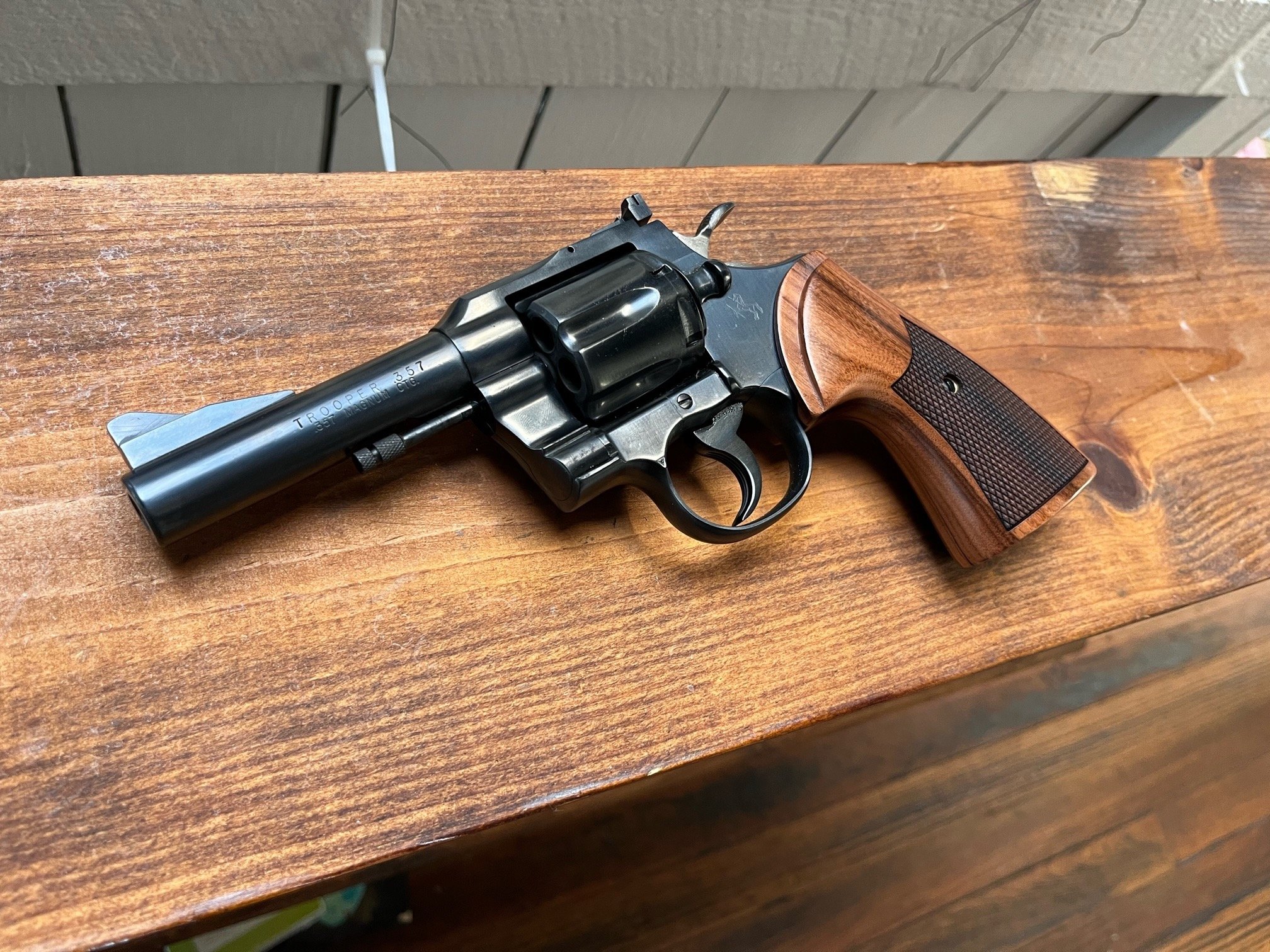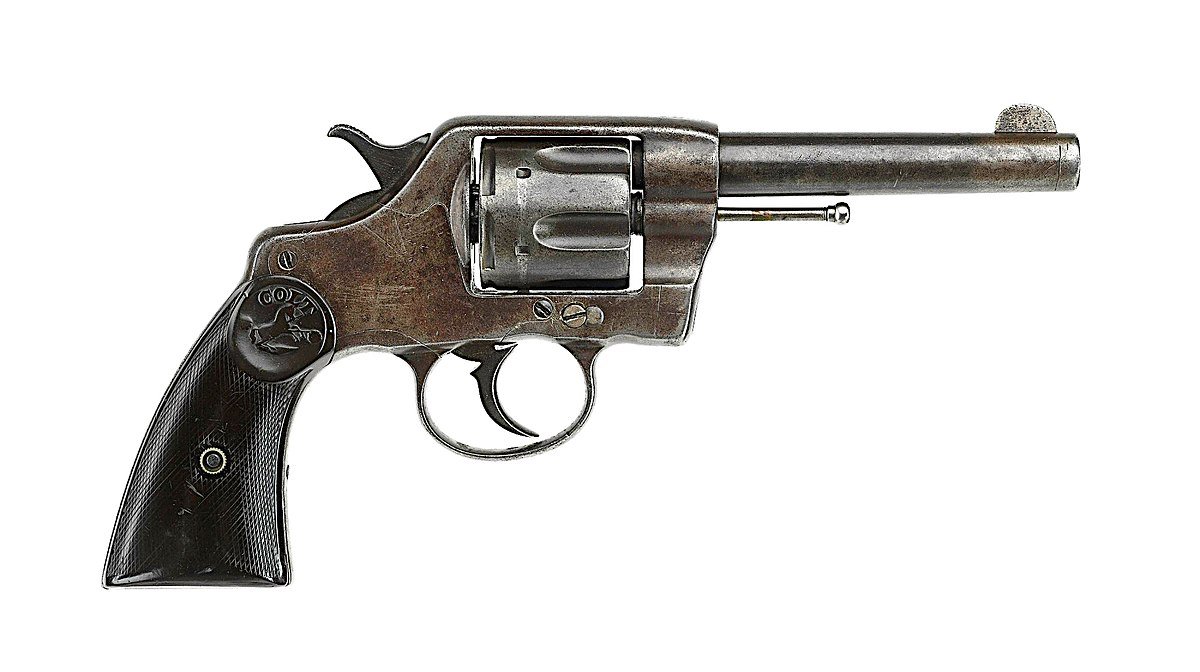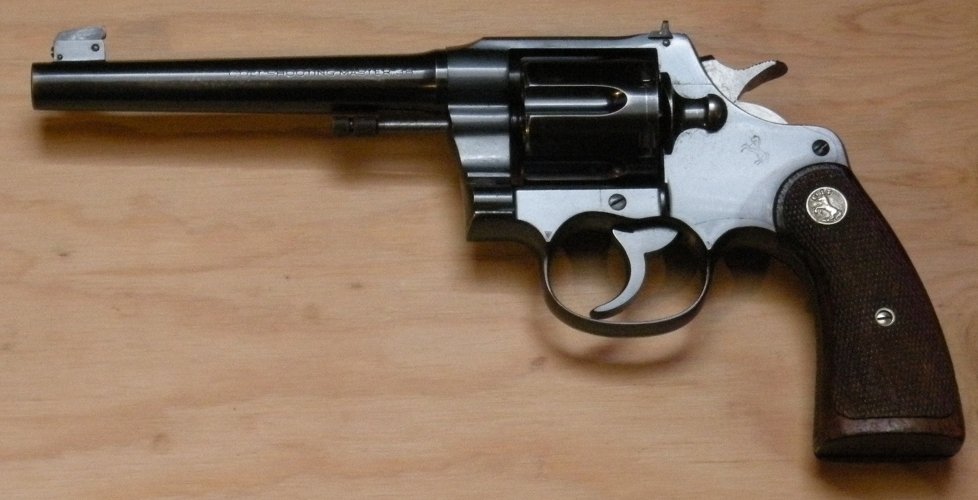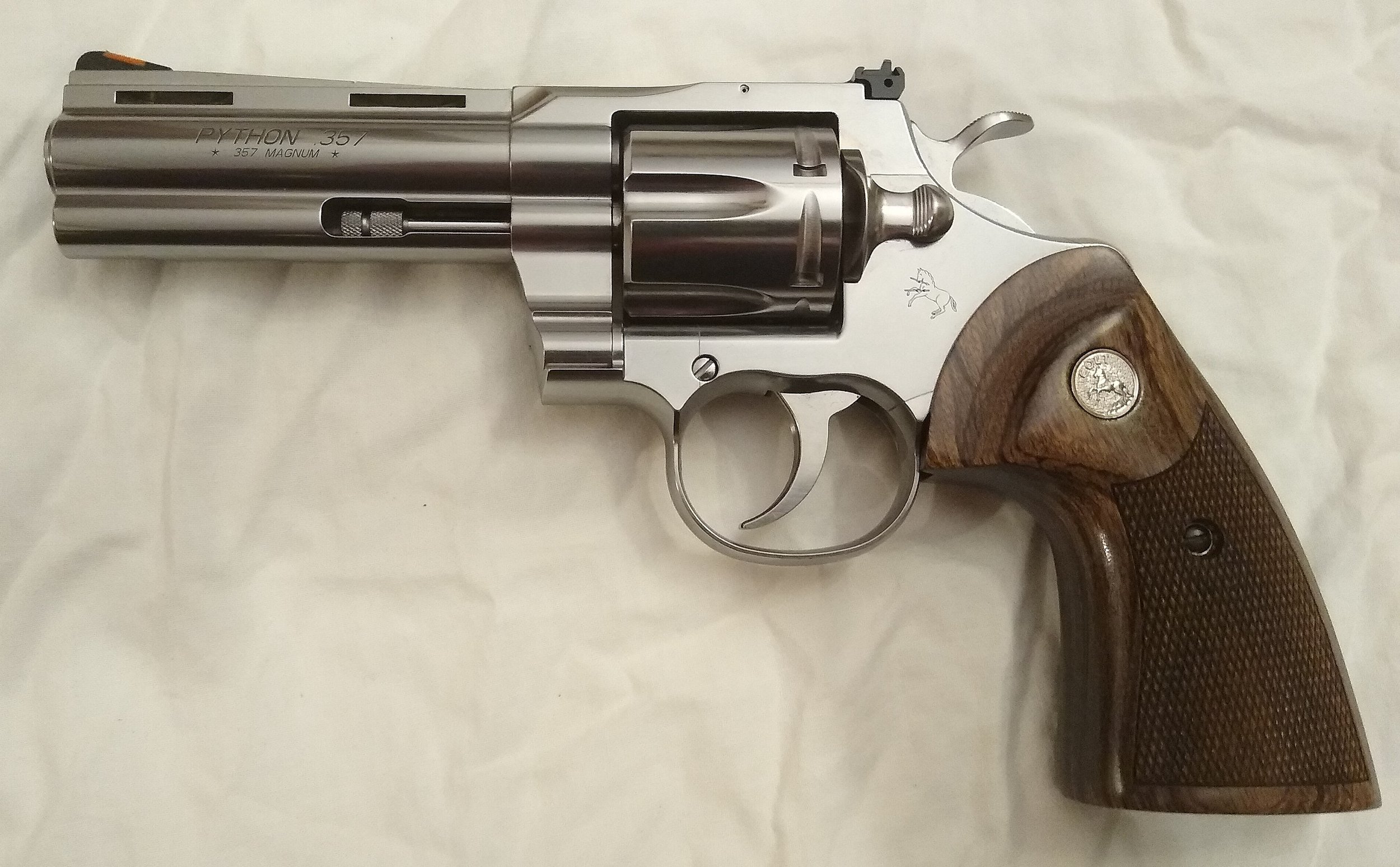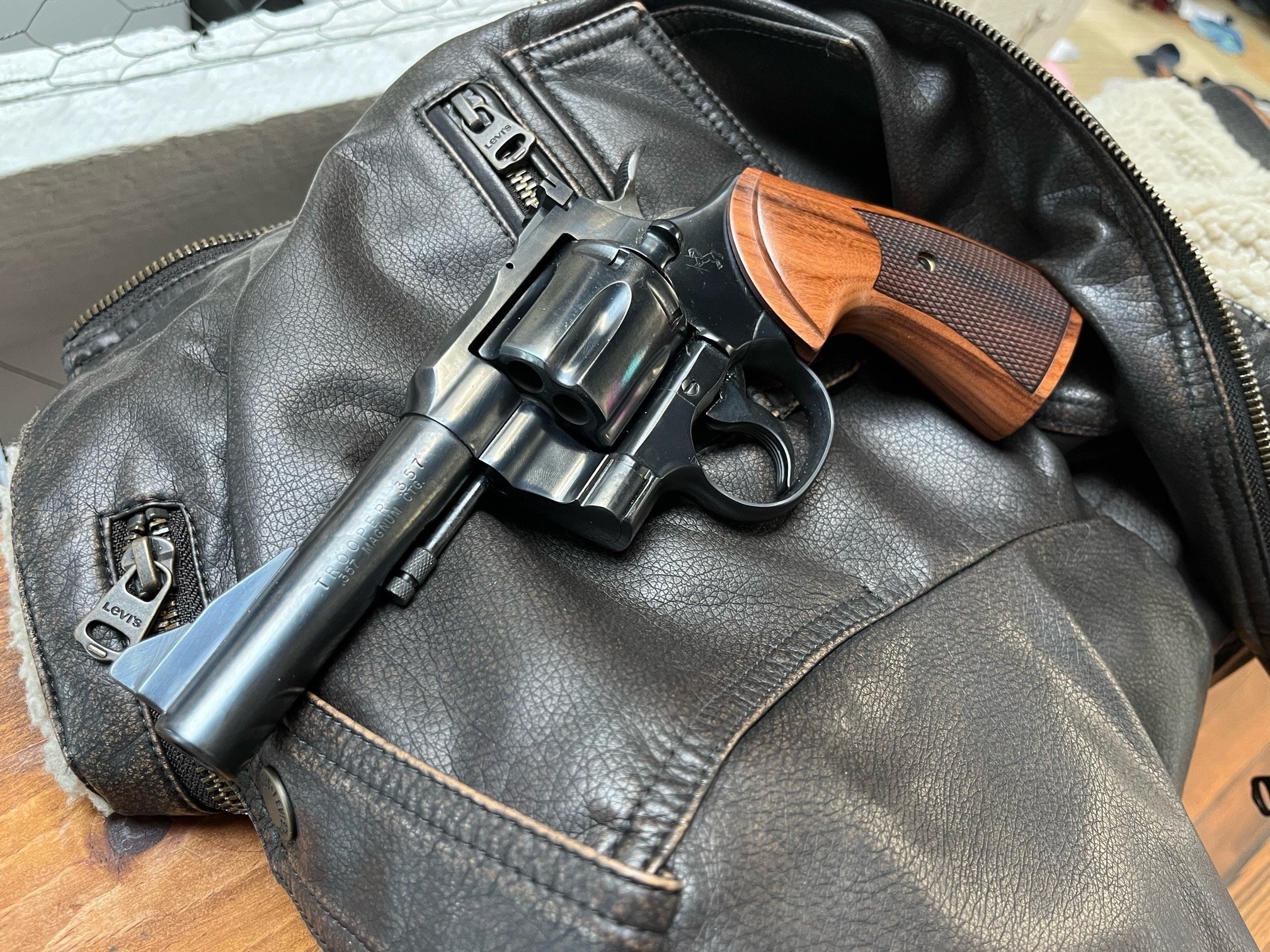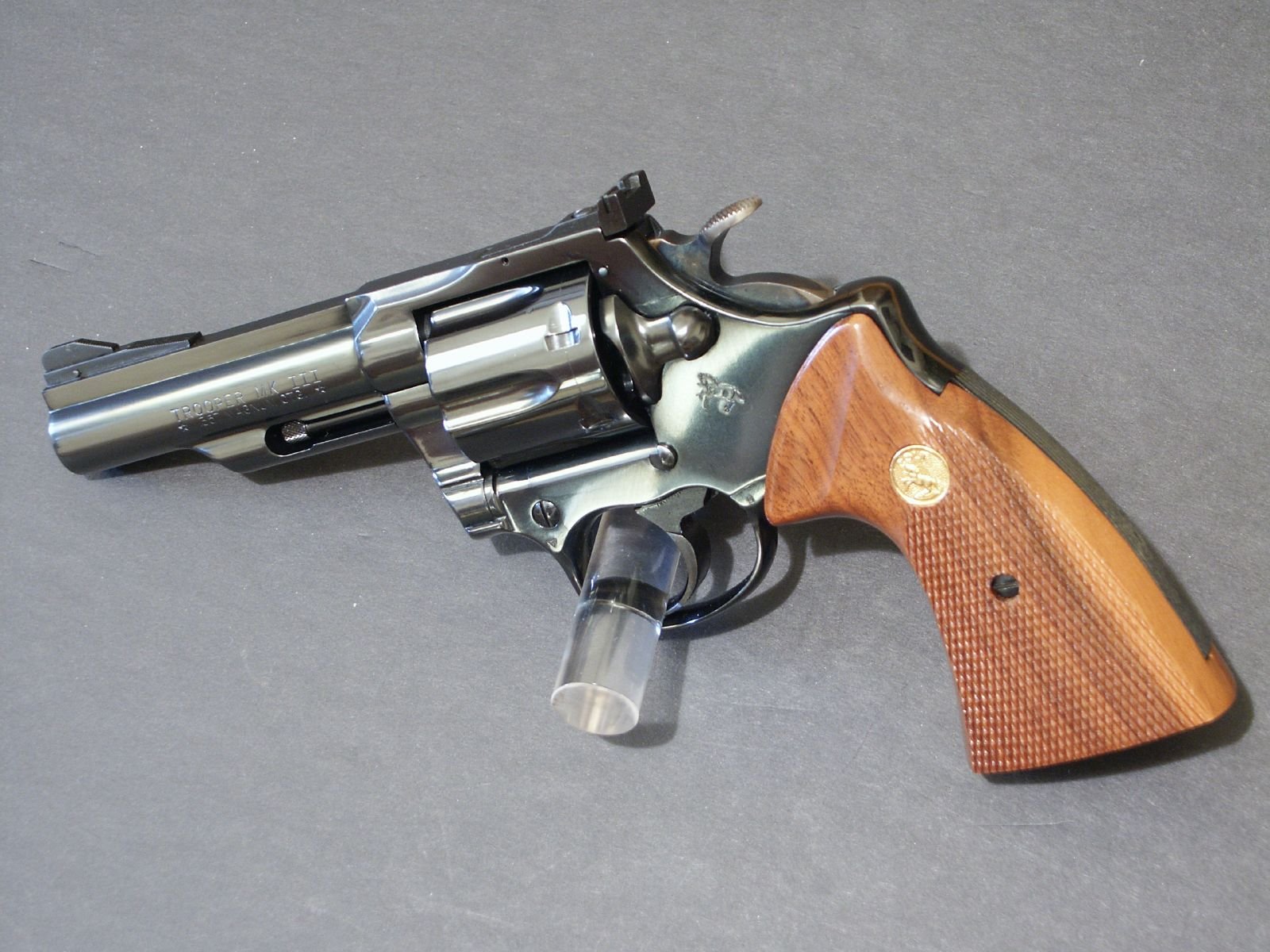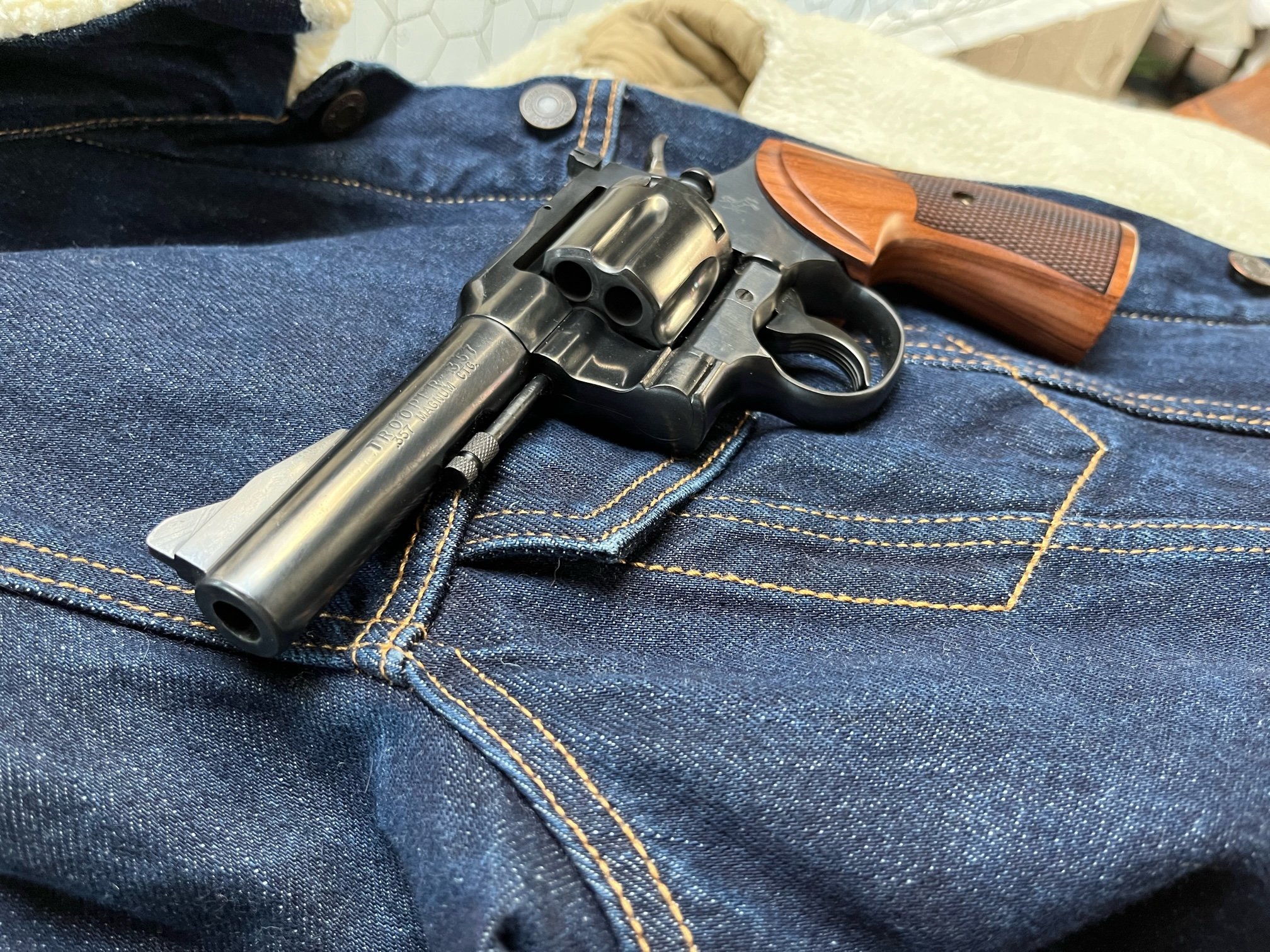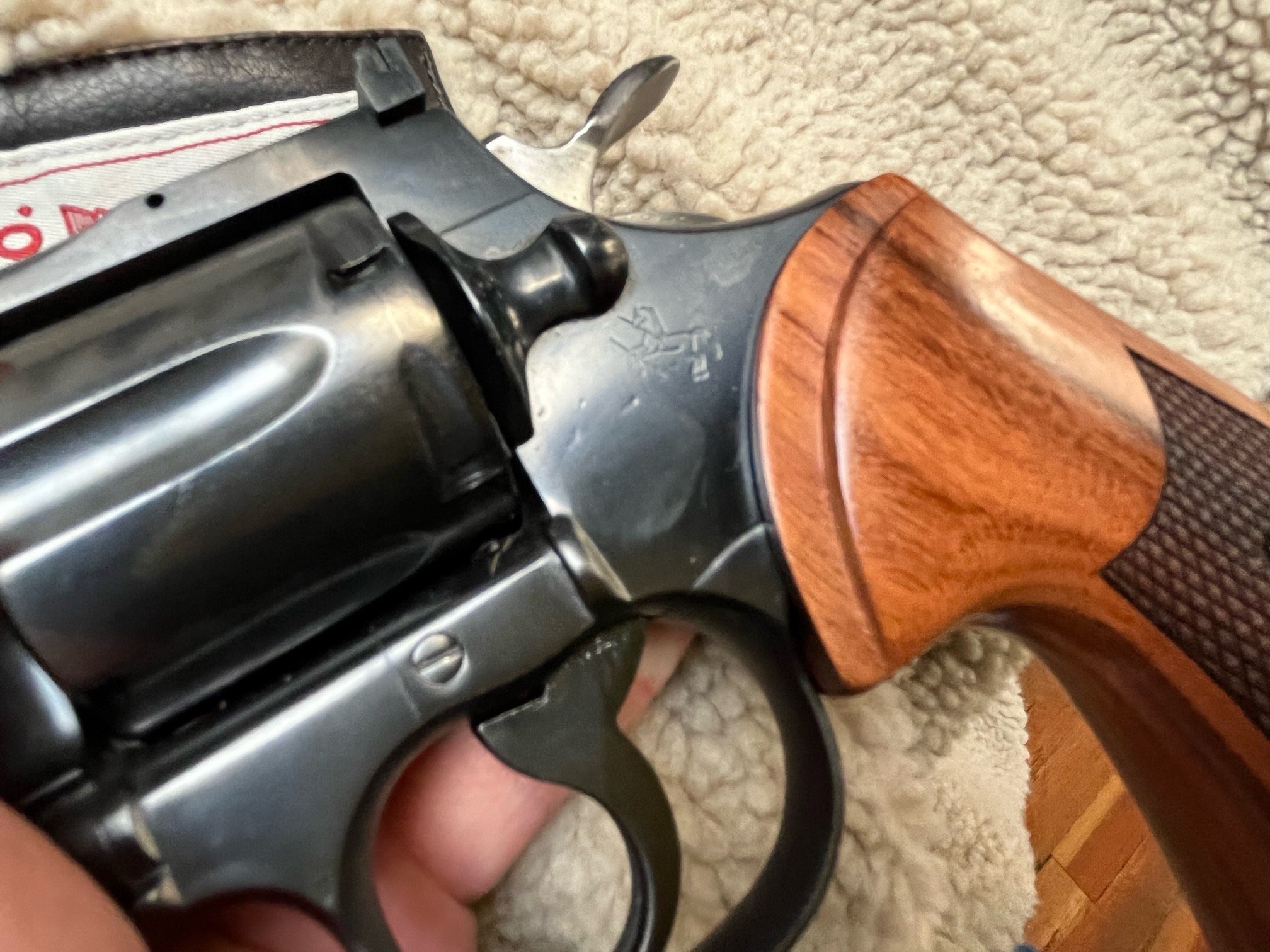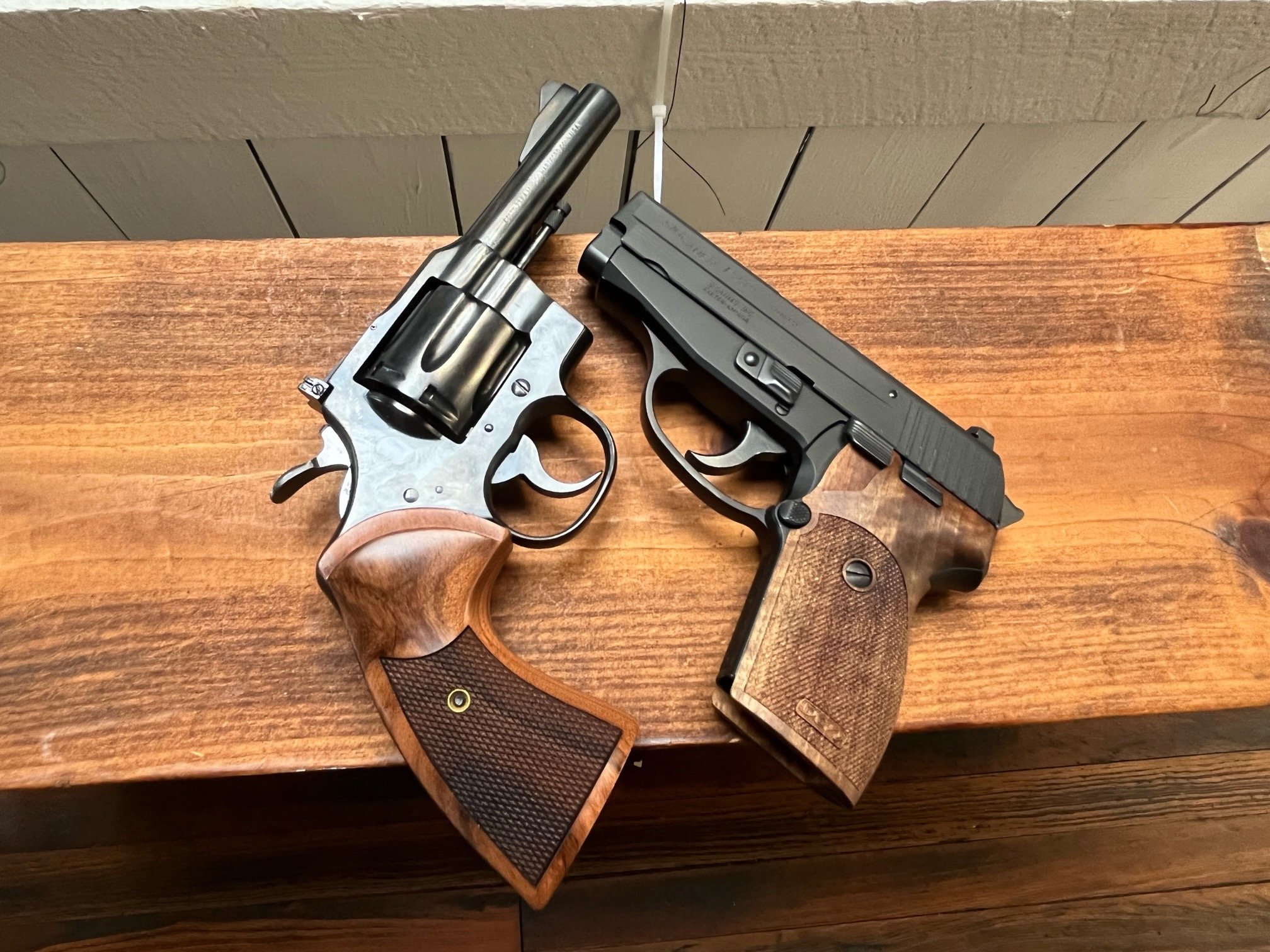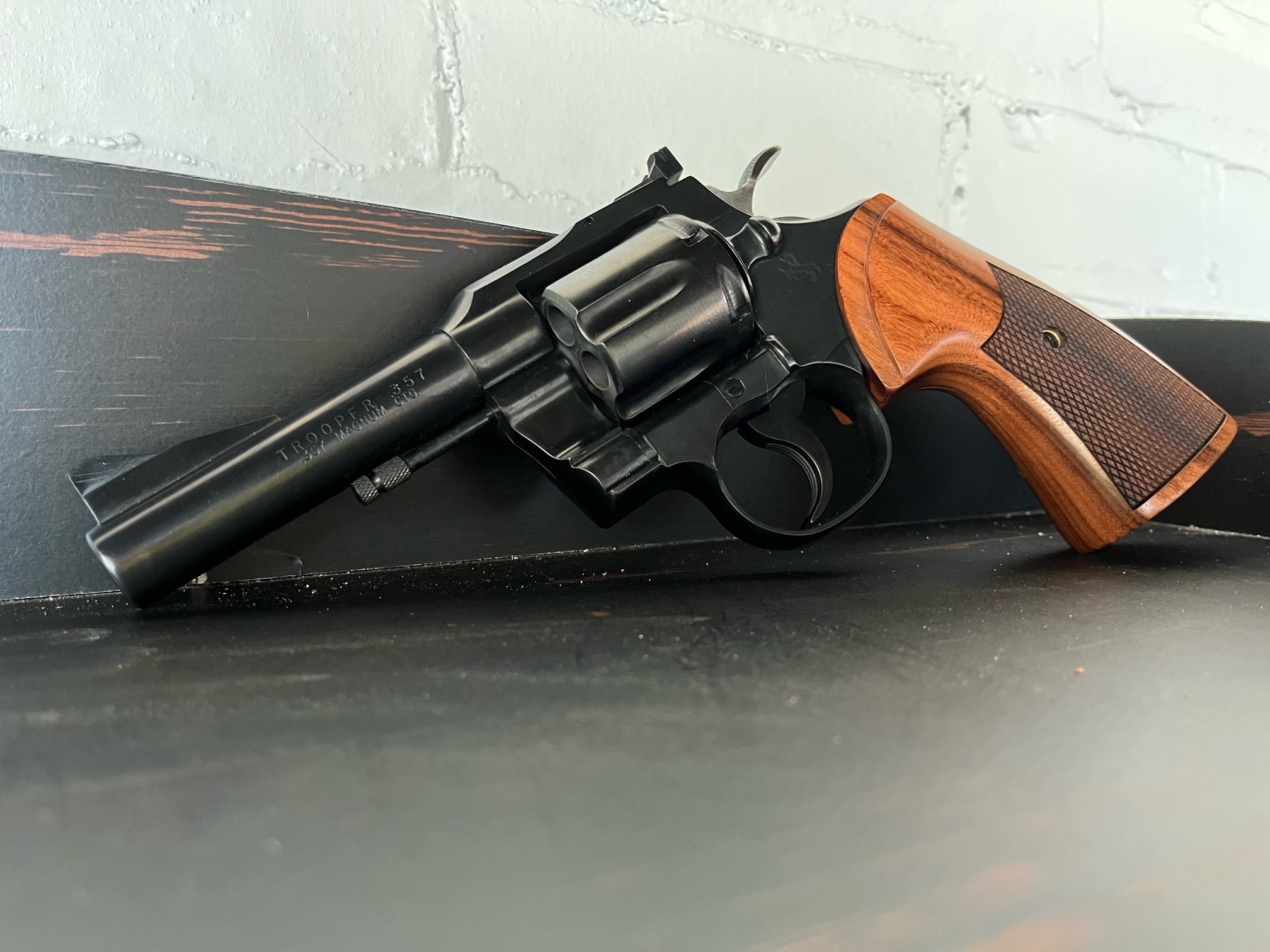Colt Trooper .357 Review: Plain-Jane Python
What if I told you the Colt Python had a sister?
Fun. Down-to-earth. Kinda quirky. I mean, yeah—she’s a little awkward at family barbecues and she dresses kinda like Avril Lavigne forgot to do laundry.
But she’s still a Colt, bro.
And so, my fellow gun hipsters, I’d like to introduce you to the Colt Trooper .357—the Python’s unpretentious, underappreciated, un-underlugged sibling. Who happens to be a woman, for the purposes of this metaphor.
We invite you to substitute other genders / pronouns above, depending on your preferences. Thank you.
–The HipTac Consortium for Half-Assed Political Correctness (H.T.C.H.A.P.C)
My 1965 Trooper. Those curves… damn…
What makes the Colt Trooper .357 hipster worthy?
Mechanically identical to the Python, the Colt Trooper .357 of the 1960s replicates the form, feel and function of its more finely finished sibling—at a less finely finished price.
Now, before we get ahead of ourselves, there’s one thing we’ve gotta get straight:
Not all “Colt Troopers” are created equal.
You’ve got Trooper MKIIIs from the 1970s, Trooper MKVs from the 1980s and .38 special Troopers from the 1950s. Those are all very different guns with very different mechanics.
But the Trooper .357 of the ‘60s (like mine) literally is a Python. Same parts. Same action. It even has the Python’s “bank vault” lockup—which freezes the cylinder in perfect alignment with the forcing cone, whenever you touch the trigger.
It just looks… frumpier.
In addition to having a less-sumptuous finish, the Trooper lacks the Python’s beautifully lugged and ribbed (for your pleasure) barrel. The absence of the underlug leaves the ejector rod untidily exposed. And without the rib as a foundation, the front sight towers awkwardly over the barrel like some kinda giant blued ziggurat (which is a Mesopotamian pyramid, of sorts).
Nevertheless…
Good Genes are Good Genes
Despite its more “bohemian” sense of style, the Trooper’s pleasing proportions still draw the eye and warm the heart. Its bold contours flow with the same sensuous poise as those of its “celebutante” sibling. And when it’s in your hand… it commutes a sense of grace and guts that only a classic .357 revolver can.
Handles just like a Python… with a front sight designed in ancient Babylon.
And of alllll the classic .357s, perhaps none are MORE classic than the Trooper/Python siblings—affectionately known to hipsters, nerds and Colt aficionados as the “I-Frame” guns.
Launched in the 1950s, Colt’s big, sexy I-Frame revolvers redefined what a premium revolver could, should and wanted to be. In fact, the I-Frame guns are often credited with inspiring the now ubiquitous Smith & Wesson L-Frame guns—which include the beloved 686 and 586.
She’s not glamorous, per se—but she’s still a looker
But, like the Vanderbilts, Kennedys and Kardashians, the most illustrious family dynasties often arise from the humblest of origins. Or the OJ trial. And in the case of the I-Frame, we can trace its roots back to the very dawn of Colt’s DA revolvers.
1889: The Year the V-Spring Sprung
The first inklings of anything we’d recognize as a “modern” DA mechanism show up in Colt’s Model 1889 revolver. Which was introduced in… 1889.
The Trooper/Python’s great grandp— no, we’re doing a matriarchal theme, here… “grandma” (Photo: Wikidata)
And while the 1889 platform was still fairly crude at that point, it introduced 3 key innovations that remained constants in Colt’s revolvers for the next 80-some years:
A V-shaped mainspring. With the M1889, Colt began using a distinctive flat-wire mainspring folded into the shape of a V. The DA lockwork they designed around this “V-spring” proved far superior to Colt’s earlier DA designs—which consisted of fragile, fiddly mechanisms shoehorned into Single-Action Army frames (basically).
A Swing-Out Cylinder. This allowed for faster loading while leaving the top-strap intact/connected—which became critical as Colt evolved their DA platform to handle higher-pressure cartridges that S&W’s “top-break” guns could not.
A Trigger-Locking Cylinder. The 1889’s action was designed to lock the cylinder in place when the trigger was pulled. This remained a hallmark of Colt’s DA revolvers, becoming known as the “Bank Vault Lockup.” It’s a feature that differentiates Colt revolvers from S&W revolvers to this day.
Collectively, these elements constitute Colt’s “V-Spring Action.” And it was the only type of DA action Colt offered until 1969, when the Trooper MKIII (which, again, is unrelated to the I-Frame Trooper .357) was introduced. More on that later.
New Service, Too Late
By the time Colt perfected the V-Spring platform, the revolver’s days as a military-service sidearm were numbered. And though the U.S. Army did adopt Colt’s “New Service” model (the successor to the M1889) as the M1909…
An example of the Colt New Service revolver, adopted as the M1909 (Photo: Wikipedia)
We all know what happened two years later.
From that point on, “America’s .45” ceased to be a revolver. Nevertheless, Colt’s V-Spring wheel guns rolled on… into the hands, hearts and holsters of American law enforcement.
And eventually gun hipsters—but we’ll get to that.
Officially Official
I’m not sure I know what, exactly, qualifies a thing to be “official.” But apparently Colt does. Because in 1927, they decided to call their medium-frame service revolver…
“The Official Police.”
Primarily designed for the .38 special cartridge, it was a more compact version of their New Service/M1909. And though it started its life in 1908 as the “New Army Special”… cops bought it. Not armies. So, I suppose that warrants some air of “officiality” as far as it relates to law enforcement?
It’s official… this is officially the “Official Police.”
The OP was built on what would become known as Colt’s “E-Frame.” It was smaller than the original “New Service” frame, but bigger than the newer “D-Frame” guns—which include the Police Positive (because what cop doesn’t appreciate positivity?) and later the Detective Special. The E-Frame served as the basis for forthcoming I-Frame platform used for the Python and the Trooper .357.
But… speaking of Trooper .357s…
Troopers gon’ Troop
The first Troopers were actually E-Frame guns, chambered in .38 special—just like the OP. And while Colt had offered their larger New Service model in .357 before WWII, they discontinued all magnum chamberings during the war. So, Smith & Wesson’s Model 27 was having allll the mid-century magnum fun.
But the M27 was a big old N-Frame howitzer. Similar in size to Colt’s New Service. So, that begs the question…
What if you could cram some .357 thunder into a medium-frame revolver?
As it turns out, you totally could. You just had to move the firing pin from the hammer to the frame (for reasons I’m not entirely clear on) and improve the heat treating on the frame and cylinder.
So, in 1953, the Colt I-Frame was born. And with it, the Colt “Model .357.”
Is it a gun? Is it a caliber?
Yup.
Colt launched a gun with the same name as the bullet it fired. I mean… I guess they were trying? Thinking beyond years, letters and unqualified conditional absolutes. Brownell’s actually has a pretty cool video on the M357.
Colt “Model .357”—later renamed the “Trooper .357” (Photo: ColtFever.com)
In any case…
Colt’s “Model .357” is the same gun as my Trooper .357. Same innards. Same barrel. Same dorky front sight. But that’s not where this story ends. Because, in 1955, something new slithered into Colt’s lineup.
The Python Strikes
And when it did… all of Colt’s product-naming travesties were summarily forgiven. Because, you know, snakes kick ass.
New-production Python… but you can see how it evolved from the M357 (Photo: Wikipedia)
In reality, the Python was simply an M357 with a fancy lugged/ribbed barrel. But instead of killing-off the M357, Colt simply renamed it in 1961. And gave it a slightly crappier finish.
The result?
Was the “Colt Trooper .357.”
Which is precisely what we have here. Again, this particular example was made in 1965.
Colt changed the name of the “Model .357” to “Trooper .357” in 1961
Same I-Frames, Different Names
As of 1961, Colt had two mechanically identical I-Frame .357s intended for different consumer targets:
The Trooper .357 targeted law enforcement. It had a plain-Jane finish, a plain-Jane barrel and I’ve heard it had less hand tuning in the action.
The Python, on the other hand, was intended primarily for pimps, executives, Wayne Newton and Rick Grimes.
This service-grade/premium-grade dichotomy persisted until 1969, when Colt developed a completely new gun for their service-grade offering: The Trooper MKIII
The “MK” Lineage
Though it’s called a “Trooper” don’t be fooled: the Trooper MKIII does NOT use the classic Colt V-Spring design. It’s not an I-Frame (it’s actually a J-Frame). It’s not related to the Python, in a mechanical sense.
That’s not to say it’s a bad gun, however. From what I’ve heard, the MK guns are solid and dependable. I handled a Trooper MKV at a gun shop recently and it seemed… really freakin’ nice.
Trooper MKIII—note the distinctive partial lug (Photo: Wikipedia)
In contrast to Colt’s V-Spring action, Colt’s MK action used coiled mainsprings and completely different internals. I don’t want to get into the weeds on the design… but… the Trooper MKIII matured into the Trooper MKV, which ultimately served as the basis for the King Cobras and Anacondas of the 1990s. The MK action existed in parallel with the classic Python/V-Spring action up until 1999, when Colt ceased all revolver manufacture… before starting again in 2017.
As far as I can tell, ALL the revolvers Colt makes today—including the King Cobras and Anacondas—use a modified V-Spring design. It’s not exactly what you find in the original I-Frames, and it likely borrows some elements from the MK lineage (though I don’t think any of the new Colts use coiled mainsprings, like the ‘90s King Cobras/Anacondas did).
All that said…
You can rest assured that an OG Trooper .357 from the ‘60s is the REAL DEAL as far as having a bona-fide Python action.
A Python for the People?
If you’ve read this far, your gun-hipster instincts are probably going into “hyper deal-sensing mode” right about now.
Something like…
“If the Trooper is basically a less-cool Python, it probably costs less. That means I could basically get a Python for……. LESS THAN A PYTHON!!!!!!”
Yeah, the gun hipster inner voice isn’t very articulate. Sorry.
But it ain’t wrong.
With the Trooper, you basically get 85% Python for 25% of the price—damn good deal
This Trooper—which had a pretty rough finish when I bought it—cost me about $500. An actual vintage Python from the ‘60s, ‘70s, ‘80s, ‘90s?
If you have that kinda money, you’ve crossed the threshold from “gun hipster” to “gun collector.” And I can’t help you anymore. Congratulations. It’s been fun.
But if you’re like me and you relentlessly pursue that optimal ratio of “cool” to “cost” when it comes to guns, the Trooper .357 might just be your ticket into vintage Python territory… for public-transit pricing.
So then…
If this gal’s built just like a Python…
Does she shoot just like a Python?
I wish I could tell you.
I’ve never shot a Python, current or vintage. But I have handled one of the new-production examples. And I can tell you this: a premium revolver made on 21st century machinery, with 21st century metallurgy, and 21st century MIM innards makes for one hell of a light, smooth action. But is it smoother than a vintage I-Frame Trooper?
Yup.
Nevertheless…
When you hold this prancing pony of old, you feel good.
It’s heavy. It’s sturdy. It’s solid. It reeks of old-school hand-assemblage and people who gave an honest shit about the things they put out into the world. I’m going to guess this one was a police service weapon. Back in the day, lots of cops carried .357s—and the Trooper was a mainstay. Someone off-handedly told me KY State Police (I live in Kentucky) carried Troopers. But I really don’t know for sure.
It just feels authentic. Pure. Just. Pragmatic. It appeals to your inner sense of heroism… even manliness.
If, you know, you’re a man.
“What was that?? Yeah… I didn’t think so…”
The gun points with an air of righteous authority. The 4” barrel reaches, but never feels overextended. With its center of gravity in the cylinder, ahead of the hand, it commands an assertive presence. You feel the swoopy curve of the grip settle against your palm. You feel satisfying sense of heft in your hand. And you begin to get…
A little excited.
Single-Action Attraction
As soon as you cock the hammer, things get hot and heavy. Your heart palpitates. Your pulse quickens. Call it chemistry. Call it attraction. Call it three-fifty-_ucking-seven.
YESSS!!!
A placid denouement lingers in the wake of the blast, leaving you to consider the magnitude of the ballistic catharsis you’ve just experienced. You feel sorta like Harry in the diner with Sally. And you quickly realize… you don’t give a shit whether this thing has lugs, ribs or snake-inspired nomenclature.
Because the Trooper’s seductively curvy I-Frame makes .357… heaven. Not to mention what it can do for .38s.
And the SA trigger is pure perfection.
It’s not the lightest SA revolver trigger I’ve ever experienced. But it doesn’t have to be. It’s impeccably direct; it seems as if there’s almost nothing separating the break from the shot itself. There’s no slack. No take-up. Just a firm—but exquisitely brittle—wall.
You rest your fingertip on the trigger face. You line up your ziggura— ehrm, sights. And daintily press.
YESS!!!
There’s a hole in the bullseye’s heart. And a flutter in yours.
She could be the one. The one revolver you’ve been looking for.
50 rounds @ 10 yards, all SA. That’s as accurate as I can shoot anything (this was before I had it refinished—more on that).
But let’s be honest: A one-night stand in single-action is no substitute for a long-term relationship based on solid double-action fundamentals.
DA Decency
I’ll be first to tell you: the Trooper’s DA is very good.
I easily kept all shots in the space of 3–4 inches, shooting DA @ 10 yards—which I can’t always do shooting a semi-auto in DA. Certainly, it offers a better DA pull than all but the very best DA semi-autos.
That said, the DA pull is not mind-blowingly light or flawlessly smooth. It can’t compare to the DA stroke on a brand-new Python or a King Cobra (both of which I’ve handled). On the newer ponies, the travel is lighter. The cylinder turns easier. All the moving parts just seem to… glide.
The head is all DA @ 10 yards—the flyers were from rapid-fire “cylinder dumps.”
In my opinion, this Trooper’s DA can’t compete with a modern 686, either. I find some stacking near the end of the stroke, with the old Colt. Not a ton. But it’s there. At the end of the day, it’s just not quite as good as what you get with a modern Smith.
To that point…
Smith revolvers have really good DA triggers in my experience. I’ve shot some recent-production 686s. I’ve owned a model 66-1 from the early ‘80s. They all had better DAs than this Trooper.
But…
When relationships really last, sometimes the “action” can get a little lackluster. Especially when it comes to revolvers (see what I did there?). And, to that end, Colt DA revolvers offer something the Smiths don’t.
Lockup the Love
I’ve owned two vintage revolvers in my life: this Trooper and (like I said) a S&W Model 66-1.
Both of them had the same timing issue: “Failure to Carry Up.”
That means the cylinder fails to fully lock into its notch if you cock the hammer sllllooooowwwly. Now, if you cock the hammer with some gusto, the momentum pulls the cylinder into full lockup and it’s all fine. But, technically, the action should fully lock up no matter how slowly you cock the hammer.
From my research, this condition is pretty common in older revolvers. And though it’s not ideal, it’s not that big of an issue. On a S&W, the force of the blast itself is supposed to help center the chamber relative to the forcing cone. But I guess there’s some potential for shaving lead (and damage to the cone) depending on how far off the alignment actually is.
But with a Colt, it’s far less of a concern. Because the classic Colt V-Spring action—dating all the way back to 1889—locks up perfectly as soon as you touch the trigger.
You can literally see it happen. If I cock my Trooper slowly (which sounds uncomfortably suggestive), then hold the hammer as I touch the trigger (it’s not getting any better, is it?)—you can see the cylinder snick over into full lockup.
And let me tell you…
That cylinder is LOCKED whenever there’s any pressure on the trigger. The hand (the thing that turns the cylinder) and the bolt (the thing that locks the cylinder) completely immobilize the action so the operant chamber lines up perfectly with the forcing cone.
Every time.
Without the trigger lockup, there’s actually quite a bit of play in the cylinder of this old gal. But as soon as you touch that trigger, she locks up as tight as any brand-new revolver. Maybe tighter.
This is what’s known as the “Bank Vault Lockup” feature.
It’s quite impressive, honestly—especially for a 58-year-old piece that looked like it spent the ‘70s in a grimy basket-weave holster, pressed up against the sweat-soaked seats of a Ford Crown Victoria.
Speaking of that…
Former Glory?
I got this thing refinished.
Seeing its sorry-looking pitted finish was kinda… disheartening. I felt it deserved better. I felt it deserved a chance to have its bluing shine, once again.
So, I took it Schlosser Gunsmithing in Newport Kentucky—just down the street from where I live. They specialize in working on older/vintage pieces and have experience with the old-school Colt V-Spring action. I figured it was worth a shot to see what they could do with this thing.
Before its “makeover”…
Pictures probably don’t do it justice. But the bluing they applied is deep, rich and very consistent overall. It’s not quite on the level of the original royal blue finish on the Pythons. But it’s really nice. And it gives this gun an attractive—yet practical—finish that’s going to keep the metal intact for years to come.
To me, it’s a look that suits the “pragmatic beauty” of the Trooper—which was never meant to be glamorous in the first place.
After—Schlosser Gunsmithing turned a beater into a beauty.
That said…
You still can see some of the pitting under the fresh bluing. But I never expected the gun to perfect. I expected the gun to look good (it does) and resist further finish degradation (which it certainly will). So I’m happy.
Was it worth the $350 I put into it?
In a purely financial sense… probably not. I don’t know if I’d be able to sell this gun for $850 - $900—which is roughly what I’ve got in it at this point.
Do I care?
Nope.
Some of the pitting is still visible, under the blueing—but it’s still a beautiful piece.
Dirty Secrets
So, after the makeover, the ole’ gal looks damn good. And she shoots good. And she feels good.
But everyone has some baggage, right? You get into a relationship. You find flaws. You discover quirks. And you make the best of it.
Well…
I’ve noticed that this Trooper has some issues once it gets a little… dirty.
After a range trip, the action tends to get a little sticky. In other words, the cylinder rotation gets “hung up” when cocking the hammer or pulling the trigger in DA. Sometimes the hammer will just stop… and I’ve gotta wiggle it and “finesse it” past the hitch.
But as soon as I scrub the soot off the action parts (the star/ratchet, the hand, bolt) the action smooths out and you’d never know there was an issue.
Initially I thought maybe the side-plate screws were loosening up while shooting. That’s what was happening on some of the newer 2020 Colts, I believe. But, I Loctited the screws on this trooper and still noticed the issue. And… the fact that the issue only manifests after shooting (more than about 100 rounds), then completely goes away after cleaning, suggests (to me) that it’s “gunk related.”
I tend to think the fouling kinda congeals after the gun cools off and that’s what’s causing the action to stick. In fact, it seemed worse when I was shooting low-quality reman, so… that sorta corroborates the idea that more fouling = more action-stickiness.
Would a newer revolver have these issues?
I don’t know.
Even newer revolvers are not immune to timing/turning issues when they’re crudded-up. Honest Outlaw talks about this when he reviews his newer 686.
A newer ratchet with cleaner edges might power through gunk better… maybe.
But…
I tend to think a newer revolver with fresher, sharper edges on the hand/ratchet/bolt will probably power through congealed gunk better than a well-used service revolver—which probably spent its retirement shooting Pabst Blue Ribbon cans outside a trailer in some seedy holler.
Yeah—the gun could probably use an action tune to go with its makeover.
All that said…
This Trooper functions perfectly at the range… when you’re at the range. It will deliver cylinder after cylinder of accurate, powerful JUSTICE whenever and wherever you need it.
You just gotta clean it afterwards.
Your one and only?
As you can probably guess, I’m mainly a semi-auto shooter/carrier/user. Chances are, you probably are too.
That said, I love revolvers. And I want more revolvers. But, for the time being, I wanted this Trooper to be my one and only wheel gun. My magnum mistress, if you will.
That’s exactly what it is, at this point.
And I feel fully confident in its ability to accurately launch magnums at my foes with poise and aplomb.
My Trooper .357 with my only OTHER .357 at the moment: the Sig P239
So then…
Should you choose an old Colt Trooper for your one and only .357 flame? After all, it’s the closest you’re gonna get to a Python for less than a grand.
Truth be told, it’s hard to say a brand-new Smith 686 wouldn’t be preferable to an old Trooper in just about every way. The same could be said of the new Colts—which, despite what the jaded MIM-haters will tell you… are really, really nice guns. I’d kinda like to get my hands on a 3-inch King Cobra, myself. Or a 3-inch 686.
Considering all that…
If you run across an old Trooper (or an M357—again, same gun) for a decent price and you’re aware of the caveats… go for it. Yeah, she may not be an actual Python. But once you spend a little quality time with her, you realize there’s more to a life than big… umm… lugs.
No, it’s not a Python… but with lines like that, it sure doesn’t feel like you’re settling.
The Trooper .357 is a solid gun and an affordable example of traditional Colt quality. It shoots well. It handles well. And it has all the makings of happily ever-after gun hipster relationship.
Thanks for reading.
What are your thoughts on the Colt Trooper .357? Experiences? Opinions? Scathing condemnations on my review? Feel free to share below…
#hiptac
© 2023, Hipster Tactical


